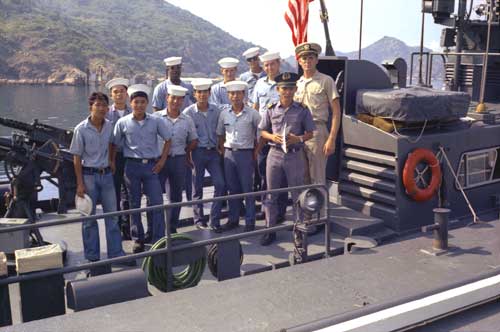
| VNN Turnover Training |
| Binh Ba - Cam Ranh Bay |
| February-March 1970 |

|
| Images on this page Copyright � 2003 by William L. Rogers. |
In February 1970, LTJG Bill Rogers was assigned to take over PCF-5 and, along with PCF-12, travel from the Swift base at An Thoi north to Cam Ranh Bay where the two boats would be overhauled. Upon completion of major maintenance and retrofit, Bill and his USN crew were to train a South Vietnamese Navy crew to take over PCF-5 in conjunction with the close out of Coastal Division 14 and turn over of all of this division's boats and facilities to the VNN under the Vietnamization program |
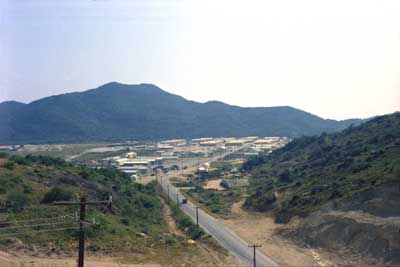 |
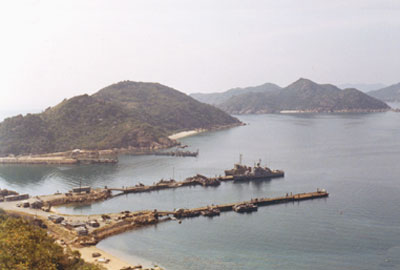 |
By 1970, the US Naval base at Cam Ranh Bay, and the nearby VNN base at Binh Ba, had significantly expanded from the capabilities present just three years earlier. The number of berthing and administration buildings had increased, vessel maintenance facilities were greatly enhanced to conduct overhauls, and there were now two substantial piers for vessels assigned there. Compare these images with similar ones taken in 1967 in the section of this web site visiting this base during the earlier time frame: Cam Ranh Bay |
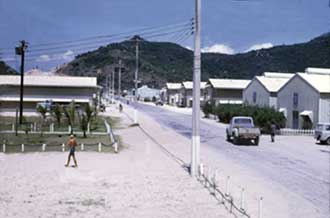 |
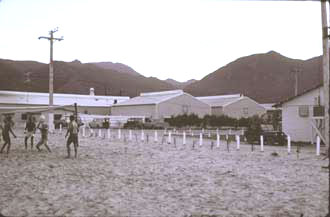 |
|
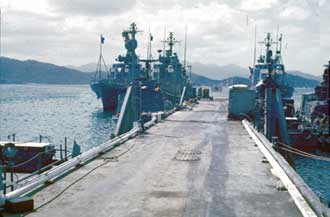 |
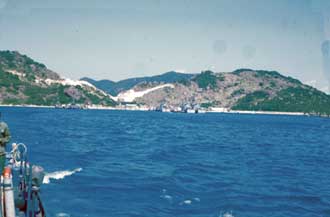 |
| Images of downtown Cam Ranh and the gunboat pier courtesy of Ray Ballew |
Upon completion of the retrofit, the USN crew was matched up with the Vietnam sailors to start the month long training and turn over period. Bill is seen in the newly refurbished pilot house reviewing the turnover program to be conducted. Webmaster note: The addition of a seat in front of the chart table was convenient |
 |
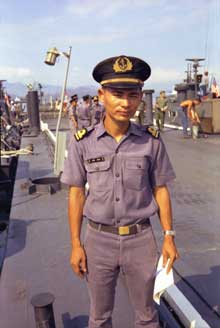 |
Bill's counterpart in the VNN would be Trung Uy {LTJG} Le Cu, the Officer-in-Charge of the new crew when the boat was turned over. The VNN complement would consist of the OinC and another six enlisted sailors especially selected from the Vietnamese fleet for the duty. |
As was the case with the USN crews, the first order of business was to form a workable team effort, become acquainted with the
equipment capabilities of the boat, and to aquire the necessary seamanship skills needed to operate the vessel under all conditions.
On the right, the VNN crew is getting familiar with the pilot house equipment functions and at the same time forming the bonds
necessary to perform as a crew.
|  |
 |
Here the Vietnamese crew practices the important evolution of recovering "Oscar" (a floating dummy) in order to hone the boat handling skills and the associated tasks required for the routine job of retreiving personnel that ended up in the water for whatever reason. By this point in the prosecution of the waterborne interdiction and pacification strategy of the Swifts, going alongside other vessels to board and search was only occasionally done. But seamanship skills were never the less very important. |
As might be expected, the differences in culture and language between the American Swift Boat sailors and their VNN counterparts were issues to be overcome during the turnover period. Only the VNN officer, Trung Uy Le, spoke limited English. And, of course, the American sailors understood only a few phrases in Vietnamese. Therefore, most of the training was performed by the hands-on demonstration method. | 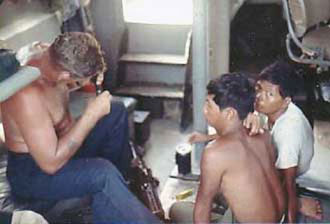 |
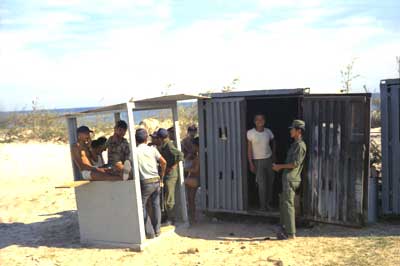 |
And true to the traditions of most Swift Boat crewmen, the VNN sailors tended to be somewhat rowdy in their off duty "relaxation" activities. From inside a conex box, one of the new PCF-5 VNN crew had to be "retrieved" from the make shift brig prior to starting that day's work-up schedule. But once on the boat, the VNN trainees took their responsibilities and jobs seriously. They knew that their lives, those of their shipmates, and the boats themselves depended on their performance. |
The training also had to be conducted in conjuction with the ongoing conflict. The remains of a victim of a sapper attack on commercial shipping in the Bay of Cam Ranh presented not only a hazard to boat navigation, but also a reminder that the lessons learned would soon be put into actual practice. Although Cam Ranh Bay was still considered a quiet area of Vietnam, the huge importance of the port facilities to the allied war effort made it a frequent target of attacks to disrupt the massive flow of material and personnel into the country. |
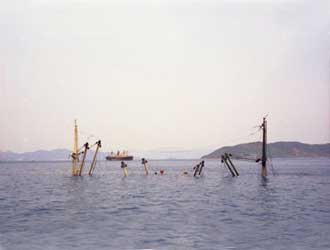 |
In that respect, Cam Ranh was a near ideal location for the VNN sailors to become skilled with their new acquisition. The virtually unpopulated small islands and ridges on the southern shoreline of the outer bay provided excellent places to accomplish live fire exercises for the one weapon that the VNN personnel were entirely unfamiliar with: the unique over and under .50 caliber machine gun and naval 81 mm mortar. Front loading and firing the mortar rounds took some getting used to by the "small but fiesty" Vietnamese. |
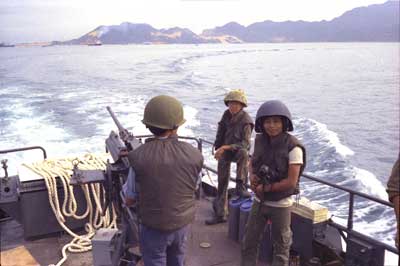 |
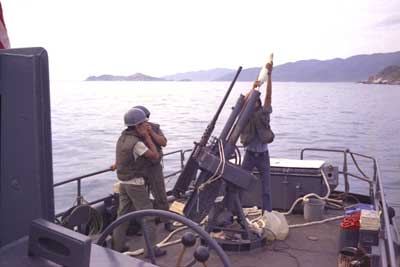 |
Even with these difficulties, the program was completed successfully. On April 1 1970 seven USN Swift Boats were turned over to the South Vietnamese in a ceremony held on the Cam Ranh Bay Swift Boat pier. |
 |
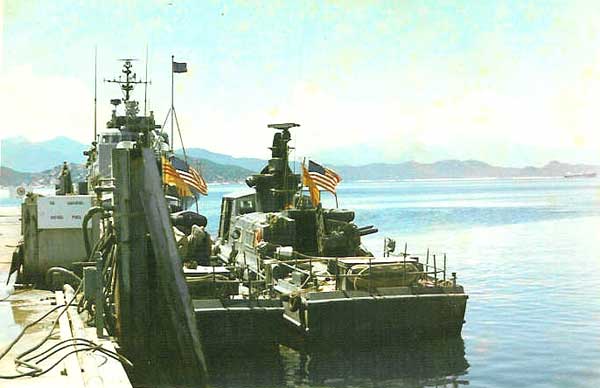 Image courtesy of Ron Braumfield |
| And with that, Coastal Division 14 officially "stood down" |
Bill and his crew were re-assigned to the still active Coastal Division 13 in Sa Dec, taking over PCF-54. They began operations in the Bassac and Mekong Rivers near Cambodia, operating from the forward locations near Chau Doc. But the paths of the US Swift Boat sailors and their recently turned over boat and crew, now designated VNN PCF 3863, would cross again very shortly during the incursion into Cambodia as part of Operation Tran Hang Dao XI. This crew was one of the thirteen VNN Swifts that joined eight US PCFs in leading the incursion up the Mekong River on May 9. |
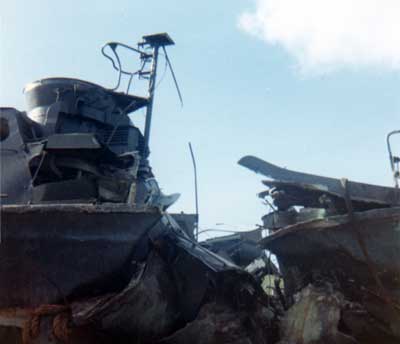 |
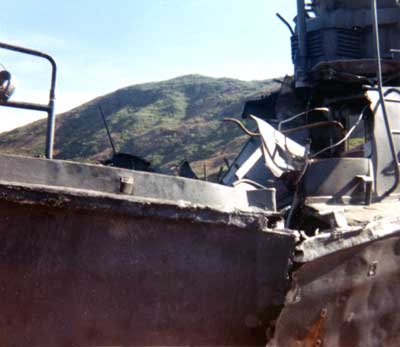 |
Sadly and unfortunately, VNN PCF 3863 would later fall victim to an enemy mine while operating on the upper delta reaches of the Mekong and Bassac Rivers. OinC Trung Uy Le would be fatally wounded in this attack, along with one of his crew members, and PCF 3863 would be completely destroyed. |
|
The war continued on with or without participation by the US
The last Swift Boats were turned over to the Vietnamese Navy
The five Mark III Swift Boats in the foreground and final eleven USN Mark I & II Swift Boats
Image courtesy of John Yeoman
Thus ending the five year history of US Navy operation of these tough little boats in Vietnam
|
This web site is Copyright � 2002 by Robert B. Shirley. All rights reserved. Click on image to return to the homepage
|